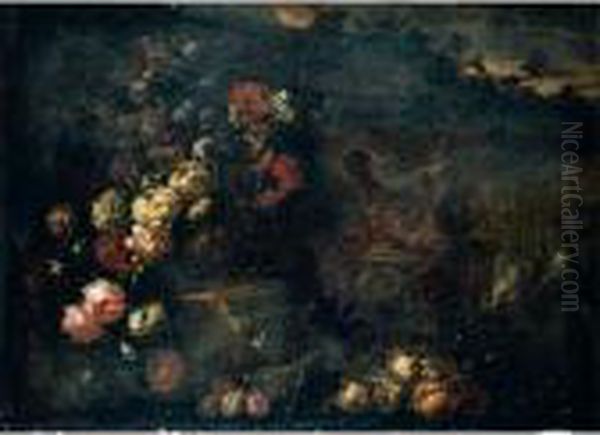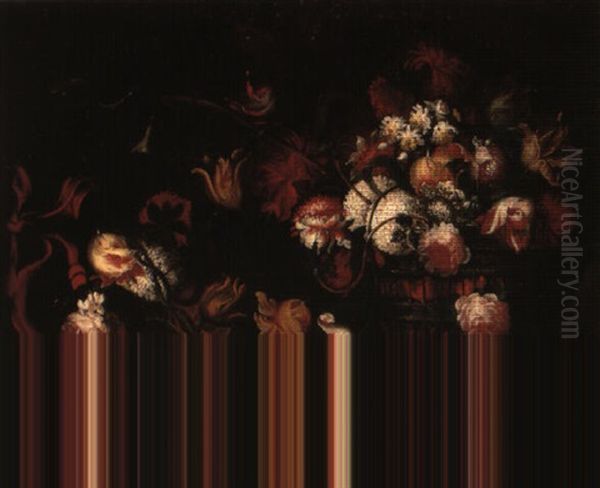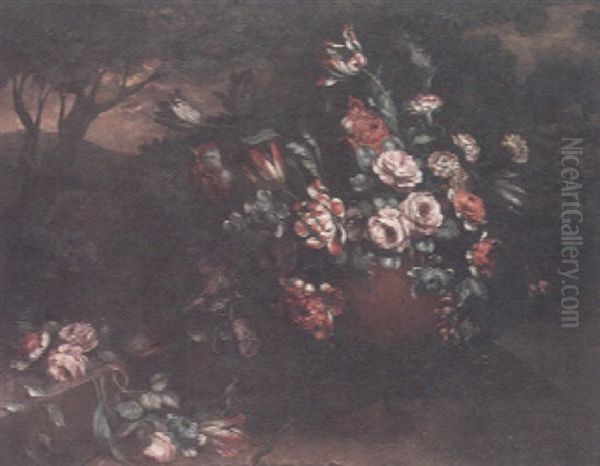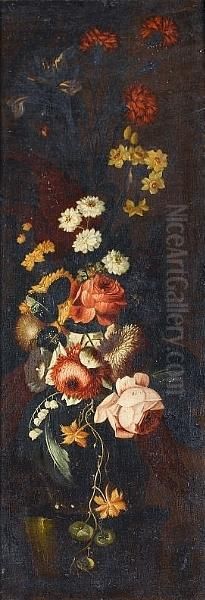Introduction: The Artist and His Time
Andrea Belvedere stands as a significant figure in the vibrant tapestry of Italian Baroque art, particularly renowned for his exquisite contributions to still life painting. Born in Naples around 1652, Belvedere navigated the rich and complex artistic milieu of his native city, becoming one of the most celebrated painters of the Neapolitan School during the late 17th and early 18th centuries. His life spanned a period of artistic transition and flourishing, witnessing the enduring legacy of Caravaggism merge with the dynamic and decorative impulses of the High Baroque. Belvedere passed away in his beloved Naples on June 27, 1732, leaving behind a legacy defined by elegance, technical brilliance, and a unique sensitivity to the natural world. His primary domain was the canvas, where he brought flowers, fruits, and occasionally birds and other natural elements to life with remarkable skill and poetic sensibility.
Neapolitan Roots and Artistic Formation
Naples, during Belvedere's formative years, was a major European cultural hub, heavily influenced by its Spanish rulers and serving as a crucible for artistic innovation. The shadow of Michelangelo Merisi da Caravaggio loomed large, his dramatic realism and chiaroscuro having profoundly impacted earlier generations of Neapolitan painters. However, by the mid-17th century, artists were exploring new directions. Belvedere emerged within this context, initially absorbing the lessons of established Neapolitan still life traditions.
His early development is often linked to the masters who preceded him and shaped the genre in Naples. Key influences include Paolo Porpora (1617-1673), one of the earliest specialists in the Caravaggesque still life tradition in Naples, known for his detailed depictions of flowers, fish, and undergrowth. Another crucial figure was Giuseppe Recco (1634-1695), a member of a prominent family of still-life painters, celebrated for his opulent arrangements of fish, flowers, and kitchen scenes, often imbued with a dynamic energy and luminous quality that moved beyond strict Caravaggism. Belvedere is thought to have learned from these predecessors, perhaps even training directly with one of them, absorbing their techniques while gradually forging his own path.
The Influence of Masters and Contemporaries

Belvedere's artistic journey was not solely defined by local Neapolitan trends. The broader Italian and European artistic currents also played a role. While he moved away from the stark drama of early Caravaggism, the fundamental commitment to realism and the careful observation of light remained foundational. His work shows an awareness of the decorative elegance favoured by Roman painters like Mario Nuzzi (c. 1603-1673), known as 'Mario de' Fiori'. Furthermore, the influence of Spanish still life painting, characterized by its meticulous detail and often austere compositions, cannot be discounted, given Naples' political ties to Spain. Painters like Juan de Arellano (1614-1676), a master of Spanish flower painting, may have provided models or inspiration, perhaps through imported works or shared artistic sensibilities.
Within Naples itself, Belvedere worked alongside and sometimes in competition with other talented artists. Abraham Brueghel (1631-1697), a Flemish painter who spent significant time in Naples and Rome, was a notable contemporary specializing in luxurious fruit and flower still lifes. Some sources suggest a rivalry, with Brueghel potentially being both an influence and a competitor, pushing Belvedere to refine his own distinctive style. The Ruoppolo family, particularly Giovanni Battista Ruoppolo (1629-1693) and his nephew Giuseppe Ruoppolo (fl. 1667-1710), were also dominant forces in Neapolitan still life, known for their lush, often large-scale compositions of fruits and flowers, sometimes with a more robust, earthy quality compared to Belvedere's refined elegance.
Belvedere's Distinctive Style: Elegance and Light
What truly distinguishes Andrea Belvedere is his unique stylistic synthesis. He masterfully blended the meticulous realism inherited from the Caravaggesque tradition with the decorative grace and dynamism of the High Baroque. His paintings, predominantly featuring flowers and fruits, are celebrated for their sophisticated compositions, delicate brushwork, and masterful handling of light and colour. Unlike the often dark and intense backgrounds of earlier still lifes, Belvedere frequently employed lighter tones or dramatic, yet luminous, chiaroscuro effects that highlight the textures and forms of his subjects.
His flower paintings are particularly noteworthy. He depicted bouquets and garlands with an almost scientific precision, capturing the specific characteristics of different species, yet arranged them with an artistic flair that transcends mere botanical illustration. Tulips, roses, carnations, lilies, and other blooms cascade across his canvases, often placed in ornate vases or spilling onto ledges, sometimes accompanied by fruits, insects, or even small animals. There is a sense of movement and vitality in his arrangements, a Baroque sensibility that animates the seemingly static subject matter. The textures of petals, leaves, and stems are rendered with exquisite detail, inviting the viewer's close inspection.

His fruit paintings share this elegance and technical virtuosity. Grapes glisten with dew, peaches reveal their soft fuzz, and pomegranates burst open to show their jewel-like seeds. These elements are often combined with flowers, creating rich, complex compositions that celebrate nature's bounty. Works like Pumpkins, Mushrooms, and Flowers exemplify his ability to handle diverse textures and forms within a unified, harmonious composition, using light to model the objects and create a sense of depth and presence. While the exact date of this work is uncertain, it falls within his active period (roughly late 17th to early 18th century) and showcases his characteristic style.
A Royal Commission: Belvedere in Spain
Belvedere's reputation extended beyond Naples, reaching the Spanish court. Around 1694, he was summoned to Spain by King Charles II, a significant honour reflecting his high standing. This period, lasting until about 1700, marked an important phase in his career. His primary task was to collaborate with the celebrated Neapolitan painter Luca Giordano (1634-1705), who was then the court painter in Madrid and extensively involved in decorating the royal palaces, most notably the vast complex of El Escorial.
Working alongside Giordano, a master of large-scale frescoes and dynamic figure compositions, Belvedere contributed his specialized skills in still life. He was tasked with painting garlands, flowers, and other decorative elements within Giordano's grand decorative schemes. This collaboration highlights the common Baroque practice of specialists working together on large projects. While Giordano painted the main narratives and figures, Belvedere added the exquisite natural details that enriched the overall effect. His time in Spain not only brought him prestige but also likely exposed him to Spanish art collections and further refined his style through interaction with Giordano and the demands of royal patronage.
The Genre of Still Life in Baroque Naples
Andrea Belvedere operated within a thriving tradition of still life painting in Naples. The city was arguably one of the most important centres for the genre in Italy, developing its own distinct characteristics. Early Neapolitan still life, influenced by Caravaggio and Flemish painters visiting the city, often had a raw, naturalistic quality. Figures like Giacomo Recco (1603-1653), Giuseppe's father, and the enigmatic Master of the Palazzo San Gervasio were pioneers.
The generation of Giuseppe Recco and Giovanni Battista Ruoppolo brought the genre to a new level of complexity and popularity, specializing in lavish displays of fish, food, flowers, and musical instruments, often with symbolic meanings (vanitas). Belvedere built upon this foundation, but steered the genre towards greater elegance, refinement, and decorative appeal, aligning it more closely with the tastes of the late Baroque and Rococo periods. His work represents a culmination of Neapolitan still life, characterized by technical perfection and a lighter, more graceful sensibility compared to some of his predecessors.
Later Life: A Shift Towards Theatre

Interestingly, according to the 18th-century biographer Bernardo De Dominici (who wrote extensively about Neapolitan artists), Andrea Belvedere experienced a significant shift in his later years. De Dominici recounts that, after returning from Spain and continuing his successful painting career for some time, Belvedere gradually lost interest in his primary art form. He reportedly abandoned painting almost entirely, dedicating himself instead to the world of theatre.
This transition suggests a multifaceted personality beyond the dedicated painter. De Dominici describes Belvedere immersing himself in "entertainment, amusements, conversation, and comedies," suggesting a passion for the performing arts and social life. He apparently only occasionally returned to his easel, perhaps to touch up older works or fulfill minor obligations. This account paints a picture of an artist who, having achieved considerable success, chose to pursue other interests in his later life, embracing the vibrant social and cultural scene of Naples. His daily routine was said to include meeting friends at a specific coffee house, among them the choirmaster of the church of Santa Maria Egiziaca a Pizzofalcone, indicating an engagement with the city's intellectual and artistic circles beyond painting.
Pupils and Artistic Legacy
Despite his later withdrawal from active painting, Andrea Belvedere's influence persisted through his pupils and followers, ensuring the continuation of his elegant style into the 18th century. Several artists are documented as having trained with him or worked closely in his manner. Among the most notable are:
Gaspare Lopez (c. 1677-c. 1732): Known as 'Gasparino', Lopez became a highly successful flower painter in his own right, working in Naples, Venice, and Rome. His style closely follows Belvedere's decorative elegance.
Baldassarre De Caro (1689-1750): Initially a follower of Belvedere, De Caro later specialized in paintings featuring animals, hunting scenes, and still lifes that combined flowers and fruit with game, developing a more dynamic and sometimes dramatic style.
Tommaso Realfonzo (c. 1677-c. 1743): Also known as 'Masillo', Realfonzo was another prominent follower, known for his refined flower and fruit compositions that clearly show Belvedere's influence in their delicacy and arrangement.
Nicola Casissa (fl. early 18th century): A Neapolitan painter active in the early 1700s, Casissa also worked in the tradition of Belvedere, specializing in decorative still lifes, particularly flowers.
Through these artists, Belvedere's approach to still life – characterized by its refinement, luminous quality, and decorative grace – continued to shape Neapolitan painting even as artistic tastes began to shift towards the Rococo. His work provided a benchmark for quality and elegance in the genre.
Art Historical Significance and Contribution

Andrea Belvedere's primary contribution to art history lies in his mastery and refinement of Baroque still life painting within the Neapolitan school. He successfully navigated the transition from the heavier, more dramatic style associated with Caravaggism towards a lighter, more elegant, and decorative aesthetic suited to the tastes of the late Baroque era. He absorbed influences from predecessors like Porpora and Recco, contemporaries like Brueghel, and the broader European context, but synthesized them into a personal style marked by technical brilliance and poetic sensitivity.
He elevated the genre of flower and fruit painting, demonstrating that still life could achieve levels of sophistication and artistic merit comparable to history painting or portraiture, at least within its own sphere. His work for the Spanish crown attests to his international reputation. While perhaps not as revolutionary as Caravaggio or as grand in scope as Luca Giordano or his later Neapolitan contemporary Francesco Solimena (1657-1747), Belvedere excelled within his chosen specialization, becoming arguably the most refined exponent of still life in Naples during his time. His paintings remain highly prized for their beauty, technical skill, and embodiment of late Baroque elegance, comparable in quality, if different in style, to the works of Northern European specialists like Rachel Ruysch (1664-1750) or Jan van Huysum (1682-1749).
Conclusion: An Enduring Elegance
Andrea Belvedere remains a pivotal figure in the history of Neapolitan art and Italian Baroque still life. From his roots in the vibrant artistic environment of Naples, influenced by masters like Porpora and Recco, he forged a distinctive style characterized by exquisite detail, luminous colour, and elegant composition. His successful career, including prestigious commissions from the Spanish monarchy and collaboration with Luca Giordano, cemented his reputation. Though he later turned his attention to theatre, his legacy as a painter endured through his beautiful canvases and the work of his pupils like Gaspare Lopez and Baldassarre De Caro. Today, Andrea Belvedere is remembered as a master technician and a sensitive interpreter of nature's beauty, whose works capture the refined spirit and decorative splendour of the late Baroque era. His paintings continue to enchant viewers with their timeless elegance and quiet virtuosity.